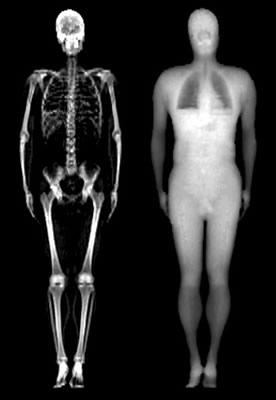
Whole-body DEXA scan showing bones (left) and soft tissue (right)
Body measurements (anthropometrics) including height, weight and waist circumference are basic components in a medical examination. They predict mortality as well as a variety of health conditions including heart disease, high blood pressure and type 2 diabetes. A commonly-used anthropometric expression is weight adjusted for height or body mass index (BMI). Dual-energy X-ray absorptiometry (DEXA) imaging technology gauges bone mineral density to identify people at risk for fractures. Additionally, DEXA provides fat and lean body composition and distribution. Determining the value of this information for health assessment has proven elusive.
City College of New York civil engineering professor Nir Krakauer and his father and collaborator, endocrinologist Jesse Krakauer of Berkley, Michigan, introduced body shape index (ABSI) as a new anthropometric measure of obesity based on adjusting waist circumference to BMI. ABSI is statistically independent from BMI and height. High ABSI correlates with greater risk of cancer, heart disease, and premature death from any cause.
The Krakauers most recent research brought together DEXA and anthropometrics to lend more insight into ascertaining health risks. They studied data collected from 10,000 subjects by the United States National Health and Nutrition Examination Survey (NHANES) between 1996 and 2006. They analyzed the NHANES data to assess the relationship between simple anthropometrics and DEXA-based whole-body fat measurements, as well as specific regional mass distribution in the limbs and trunk (torso). They adjusted the DEXA-measured fat and fat-free masses for BMI and ABSI, using the same power-law approach underlying ABSI, to isolate the information added by DEXA scans from that provided by anthropometrics.
They found high trunk fat percentage alone did not predict mortality. They also found that high fat-free mass in the trunk – rather than high fat mass – identified risk. This finding was unexpected, since trunk fat mass is usually considered to be of more concern.
“For the trunk fat-free mass group [with low ABSI], people who might not be considered high risk [by clinicians] based on existing conventional measurements, appear actually to be at elevated risk,” said Krakauer.
While high ABSI was shown to be the best single mortality predictor, DEXA imaging data revealed how regional fat free mass can also be a sign of significant health risks.
About the City College of New York
Since 1847, The City College of New York has provided a high-quality and affordable education to generations of New Yorkers in a wide variety of disciplines. CCNY embraces its position at the forefront of social change. It is ranked #1 by the Harvard-based Opportunity Insights out of 369 selective public colleges in the United States on the overall mobility index. This measure reflects both access and outcomes, representing the likelihood that a student at CCNY can move up two or more income quintiles. In addition, the Center for World University Rankings places CCNY in the top 1.8% of universities worldwide in terms of academic excellence. Labor analytics firm Emsi puts at $1.9 billion CCNY’s annual economic impact on the regional economy (5 boroughs and 5 adjacent counties) and quantifies the “for dollar” return on investment to students, taxpayers and society. At City College, more than 16,000 students pursue undergraduate and graduate degrees in eight schools and divisions, driven by significant funded research, creativity and scholarship. CCNY is as diverse, dynamic and visionary as New York City itself. View CCNY Media Kit.
Erica Rex
p: 845 668 0322
e:
erex@ccny.cuny.edu